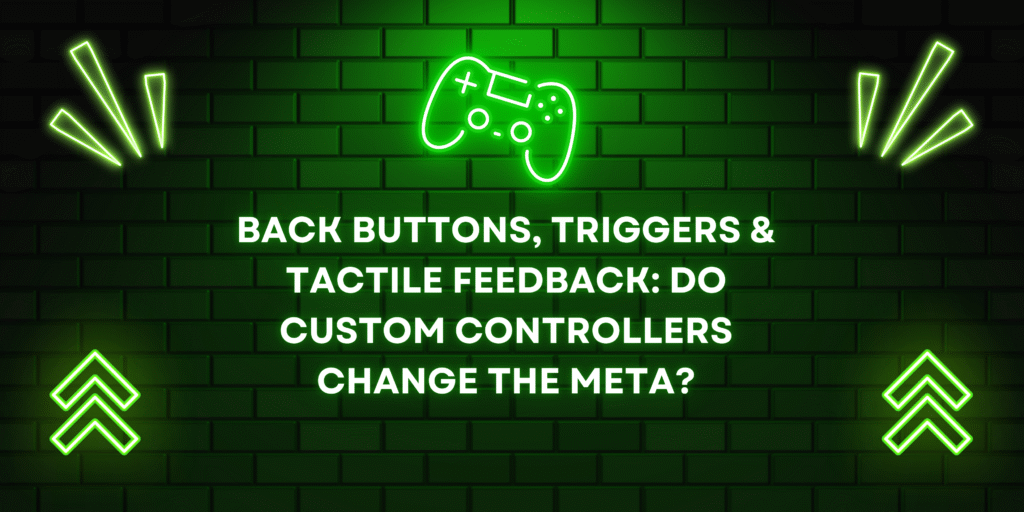“Okay, real talk—have you ever missed a shot ‘cause your thumb was just a second too late switching from the stick to the button?”
Same. And if that’s ever happened to you during a sweaty Warzone final circle or a Rocket League overtime, you already know: standard controllers just don’t cut it sometimes.
This isn’t one of those boring tech breakdowns where I throw specs at your face like I’m reading from a Best Buy label. No. We’re digging into something deeper. Something sweaty-palmed, rage-quitting, shout-at-your-TV real:
Does slapping on those back paddles and clicky triggers actually give you a competitive edge—or is it just expensive placebo with RGB lights?
Spoiler: It’s complicated. But oh man, it’s juicy.
The Problem: “Why’s My K/D So Mid If I Play Every Day?”
You’ve been grinding. Logging in every evening after work or school, warming up in the firing range, dialing in your aim like a sweaty Chad in Ranked lobbies. Yet your reflexes still feel… off.
Your thumbs are juggling too many tasks. Reloading, shooting, jumping, aiming, switching weapons, it is a total circus down there. And while your brain’s making the call, your fingers are basically on strike.
Ever watch a Twitch streamer with a 6.2 K/D and wonder how the heck they just mapped five actions in under a second without even thinking? Yeah. Same.
So what gives? Is it all skill? Or are their controllers doing some heavy lifting behind the scenes?

Agitate: “Hold Up, Am I Losing ‘Cause of My Controller?”
Let’s get painfully honest for a sec.
The first time I picked up a friend’s custom controller—with back buttons, hair triggers, and clicky sticks—it felt like cheating. No kidding. I could actually jump and shoot at the same time and not have my fingers tied in knots like I was playing Twister.
It was like discovering aim assist again for the first time.
Then I went back to my stock Xbox controller and everything felt… sluggish. My movements, delayed. My muscle memory, confused. My kills, stolen.
Suddenly, I was blaming my hardware. But here’s the thing—maybe I wasn’t wrong.
Because when you’ve been stuck in Gold for six seasons and you’re still dying in 1v1s you should win, the truth stings a bit:
Your controller might be holding you back.
Especially if your thumbs are doing all the work. That’s like trying to drive a race car with one hand and a foot out the window.
Solution: Custom Controllers—Game-Changer or Gamer Gimmick?
Okay, let’s not get too dramatic here (even though we’re clearly already there).
Do custom controllers actually change the meta?
Short answer? Yeah, kinda.
Longer answer? Depends on how serious you are about your play.
We’re talking about this when we say “custom”:
- Back Buttons / Paddles – These let you Re-map things like jump, crouch, or reload onto your middle or ring fingers. This means your thumbs never need to leave the analog sticks. That’s huge.
- Hair Triggers – Basically, these register a shot with way less pressure. For FPS games? That’s shaving milliseconds off your reaction time.
- Tactile Feedback – Ever tried clicky buttons that feel like a mechanical keyboard? Weird at first, but satisfying and precise. Especially great for fighting games or anything rhythm-based.
- Adjustable Stick Tension / Deadzones – Lets you change your analog sticks to be faster, smooth, or a combination of both depending if that’s how you want to roll.
So yeah—these aren’t just flashy gimmicks. They’re tools. Tools that, when mastered, can give you a legit edge.
Especially if you’re in competitive lobbies where milliseconds matter.
Subheading: A Canadian Perspective, Eh?
Let’s not pretend all of us can casually drop $300 on a controller like we’re made of Monopoly money. I’m in Canada too, and between the exchange rate and shipping fees? Oof.
That $200 USD Scuf turns into $280 CAD real fast—and that’s before taxes or import duties.
So is it worth it?
Well, think of it like this:
If gaming is your hobby, your escape, your thing, then yeah—it’s an investment. The same way a cyclist buys better gear or a guitarist upgrades their amp.
I picked up a used custom controller from Facebook Marketplace for $140. Took a chance, cleaned it up, and holy heck—it felt like I’d unlocked Ultra Instinct.
Even my buddy Mike, who swears by default gear and “pure skill,” tried it once and now he’s lurking Scuf and Battle Beaver like it’s sneaker drop season.
So yes, even in our snow-covered, Tim-Hortons-fueled gaming caves up north—we feel the difference.
Subheading: When Does It Not Matter?
Here’s the honest bit that nobody trying to sell you a controller will tell you:
If your aim is still shaky, your game sense is off, or you just play casually on weekends? You might not need one.
Because a fancy controller won’t save you if you’re charging mid with no cover, or if you’re still clicking reload after every single kill (stop that, please).
It’s not a magic wand.
It’s more like an exoskeleton. Enhances what you’ve already got.
So if you’re improving, pushing yourself, and grinding with purpose—yeah, that’s when it kicks in. That’s when it matters.
Conclusion: Here’s the Real Meta
So. Do custom controllers change the meta?
Yes, but only if you also change how you play them.
You won’t suddenly have Shroud-like reflexes with back paddles, and clicky triggers won’t stop you from bad decision making.But they’ll let you optimize your play. Cut the fat. Map smarter. React faster.
And when every frame counts, every button press feels right, and your loadout finally matches your skills? That’s when you feel the difference.
That’s when the meta stops being a thing you read about on Reddit—and starts being something you define every time you queue up.
So whether you’re a weekend warrior from Winnipeg, a streamer in Vancouver, or just some dude in Toronto like me who wants to climb one more rank before bed—ask yourself:
Is it time to give your thumbs some backup?

Leave a Reply